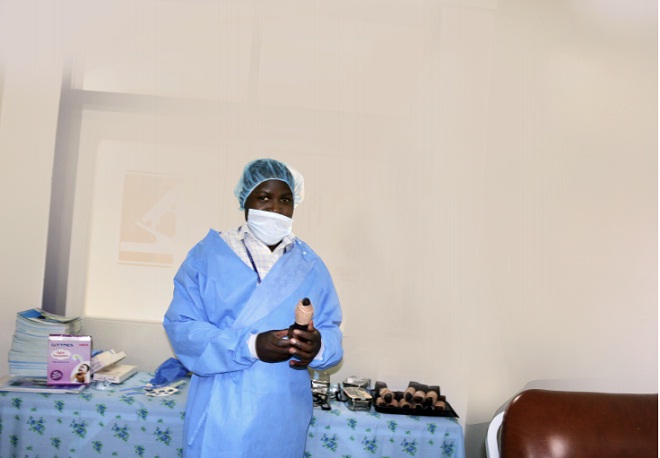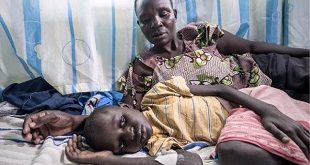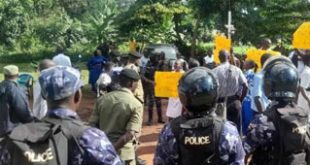Circumcision figures per year
2010 – 9,052
2011 – 57,132
2012 – 368,490
2013 – 801,678
2014 – 878,109
2015 – 556, 673

On the day he was circumcised, Sylvester Kule was scared and nervous. He is Mukonzo, a traditionally circumcising tribe, indigenous to the volatile Mt. Rwenzori region of western Uganda. But it was 1975 and Gen. Idi Amin Dada, who gained notoriety as a brutal president, had banned circumcision among non- Muslim men claiming its rituals were a cover for military training. Issued a year before he was to be circumcised, Amin’s decree shattered Kule’s childhood dreams.
“My father had always told me and my brothers that the ritual would transform us into strong brave men ready to marry and start our own families.
“I was always counting down to turning 15 to join ‘abathende,” he says referring to candidates for circumcision.
Kule had witnessed a previous Olhusumba (circumcision ceremony) that took place at the initiation site in current day Bundibugyo district. He remembers the chants, the songs of praise, and the tales told while a group of traditional leaders, the abathende, and their cheer leaders undertook the pilgrimage to the circumcision site.
“Candidates became very close friends,” he recalls, “They could never betray each other.”
But Kule did not enjoy any of that. Instead, he was circumcised secretly in the small clearing behind his father’s house in Ngangi village. It was a big risk and they could have been punished severely or even killed if caught. Even as the 56-year old speaks now, 41 years later, I get a sense of how disappointed he felt.
Stories like Kule’s, which reveal a deep-rooted passion for male circumcision, might have contributed to the enthusiasm with which the Uganda government embraced the Voluntary Medical Male Circumcision (VMMC) program recommended by the World Health Organisation (WHO) and the Joint UN Programme of HIV and AIDS (UNAIDS) in 2007 as key component of prevention intervention in countries with high HIV prevalence and low circumcision rates.
But Uganda is not a circumcising country. Apart from Muslims, only the Bakonzo and Babwisi; another small tribe on the slopes of the Rwenzori, and the Bamasaba and Sebei in eastern Uganda circumcise. The other 51 indigenous communities do not circumcise. For them, circumcision is a completely new and, in some cases, dreaded phenomenon. That is a reality that the voluntary circumcision implementers are only now starting to grapple with as they miss targets.
Missed targets
Dr. Barbra Nanteza, the coordinator of VMMC at the Ministry of Health, says the initial target was to safely circumcise 4.2 million men by 2015 in order to hopefully halve the country’s HIV incidence. Being funded mainly by donors, VMMC is conducted at 356 government health facilities across the country. Each has an implementer – a civil society organization meant to oversee all activities related to the procedure. They are given a target of males to circumcise in a year. But by end of 2015, only 2,671,134 men in Uganda had been circumcised under the VMMC programme. Nanteza says the target cannot be met even by end of 2016. Without giving specific figures, she says the Eastern region has circumcised the most men whereas Northern and Western Uganda trail. Globally, UNAIDS set a target of 27 million men to be circumcised in high HIV prevalence countries by 2020. By end of 2015, only 10 million men had been circumcised.So what is going wrong?
As Uganda registers mixed progress as regards safe circumcision, here is how implementers are getting more innovative to cut more men
A research facility, Rakai Health Sciences Programme (RHSP) in Rakai district, a high HIV risk district and where two clinical trials that assessed and confirmed the efficacy of male circumcision for HIV prevention were done, provides evidence of the challenges the programme faces. It also offers a few explanations on why.
Rakai was the centre of pilot studies conducted as early as 2004 and 2009. There was enthusiasm after they showed that circumcised men enjoyed a 73% protective effect from HIV five years later.Today, the area is intriguing because a decade later, up to 51% of the non-Muslim men are still uncircumcised.
On May 11 when The Independent visited a little before midday, the facility’s Voluntary Circumcision client waiting area which is also the health education area – was not used at all. The three clinical rooms where clients are counseled ahead of the procedure were also under lock and key. So were the two theatres where the procedure would be done.
Nicholas; the receptionist, said the lack of clients is unexplainable.
“By this time, this room would be full,” he told The Independent, “I don’t know why they no longer come.”
In an attempt to get answers, we spoke to a Senior Researcher; Dr. Godfrey Kigozi. He says increased donor-funding has enabled increased announcements inviting men for the procedure. Most men in Rakai, if not all, now know the preached benefits of safe male circumcision; including HIV prevention, controlling the spread of the Human Papilloma Virus that causes cervical cancer, and prevention of genital ulcers and other Sexually Transmitted Diseases. But, he says, for unclear reasons over time, client numbers started decreasing. In some cases, instead of the targeted older men, the centre receives more adolescents.
Sending wrong messages
Stephen Mugambe, a health communicator with RHSP, thinks he has found an explanation for what went wrong and refers to a recent special qualitative study conducted to find out what could have gone wrong.
“We found that men were bored by us talking about HIV all the time. They don’t like the medical language too,” he says.
Mugambe says many clients also said they shunned the health facilities because “they were tired of lining up with crying babies for services at the clinic”.
For Mugambe, all this means one thing; a shift in the communication from promoting circumcision as a health procedure to looking at it as a lifestyle change.
An example of the new strategy is a campaign dubbed ‘Mwami Mulembe’ or ‘stylish man’. It does not mention any thing about the health implications of the procedure. Instead, it describes a modern stylish man as one who is circumcised, one who cares about the wellbeing of his family, and one who takes charge of his and his partner’s health safety.
How `men of style’ are facing the cut in innovative battle against HIV/AIDS
It is the message emblazoned on a deep red poster with a photo of middle – aged woman.
The words on it are: “Yakomolebwa. Singan’owange akolakyekimu. Faayo eri obulamu bwo. Beera Mwami Mulembe (He got circumcised. I wish mine does the same. Mind your health. Be a stylish man)”.
The poster is difficult to miss but Mugambe is taking no chances. He hangs it everywhere in Kilisizo town center near the RHSP centre.
Mugambe has also introduced other innovations. He now has a ‘Man Van’ for men who hate the clinic. It goes around the area blasting the latest music hits, interspersed with announcements inviting men, not for circumcision but for a game.
“Games are crowd pullers but you only get a free coupon to attend after being circumcised,” he says. He also has prize winning contests where the winner is crowned as ‘Sebalembe’ or `Mr. Super style’.
The gimmicks are paying off. Before the campaign started in 2014, 37% of non- Muslim men were circumcised but a year later, the percentage increased to 49%. It was the highest annual increase recorded since VMMC started in the area.
 The Independent Uganda: You get the Truth we Pay the Price
The Independent Uganda: You get the Truth we Pay the Price


